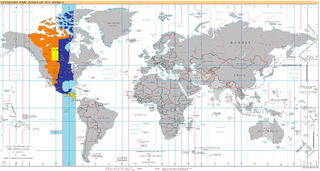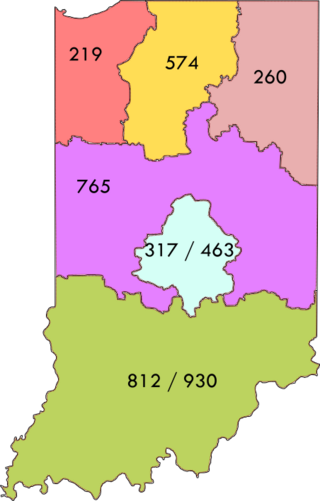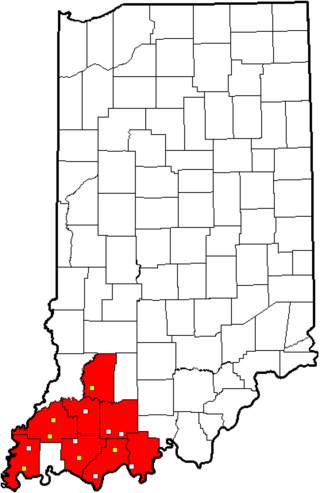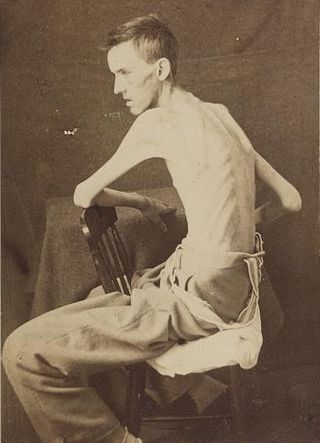
Warrick County is a county located in the U.S. state of Indiana. As of 2020, the population was 63,898. The county seat is Boonville. It was organized in 1813 and was named for Captain Jacob Warrick, an Indiana militia company commander killed in the Battle of Tippecanoe in 1811. It is one of the ten fastest-growing counties in Indiana.

Gibson County is a county in the southwestern part of the U.S. state of Indiana. As of the 2020 United States Census, the population was 33,011. The county seat is Princeton.

Scouting in Indiana has a long history, from the 1910s to the present day, serving thousands of youth in programs that suit the environment in which they live.

UTC−05:00 is an identifier for a time offset from UTC of −05:00. In North America, it is observed in the Eastern Time Zone during standard time, and in the Central Time Zone during the other eight months. The western Caribbean uses it year round.

UTC−06:00 is an identifier for a time offset from UTC of −06:00. In North America, it is observed in the Central Time Zone during standard time, and in the Mountain Time Zone during the other eight months. Several Latin American countries and a few other places use it year-round.

Area codes 812 and 930 are telephone area codes in the North American Numbering Plan (NANP) for the southern third of the state of Indiana.

The Wabash Valley is a region located in sections of both Illinois and Indiana. It is named for the Wabash River and, as the name is typically used, spans the middle to the middle-lower portion of the river's valley and is centered at Terre Haute, Indiana. The term Wabash Valley is frequently used in local media in Clinton, Lafayette, Mount Carmel, Princeton, Terre Haute, and Vincennes all of which are either on or near the Lower Wabash River.
The United States District Court for the Southern District of Indiana is a federal district court in Indiana. It was created in 1928 by an act of Congress that split Indiana into two separate districts, northern and southern. The Southern District is divided into four divisions, Indianapolis, Terre Haute, Evansville, and New Albany. Appeals from the Southern District of Indiana are taken to the United States Court of Appeals for the Seventh Circuit. The court has five judges, four full-time United States magistrate judges and two part-time magistrate judges.

The U.S. state of Indiana is divided into Eastern and Central time zones. The official dividing line has generally moved progressively west from its original location on the Indiana–Ohio border, to a position dividing Indiana down the middle, and finally to its current location along much of the Indiana–Illinois border. In April 2006, several southwestern and northwestern counties reverted to Central time, although by late 2007 all but two had returned to Eastern time.

Indiana's 8th congressional district is a congressional district in the U.S. state of Indiana. Based in southwest and west central Indiana, the district is anchored in Evansville and also includes Jasper, Princeton, Terre Haute, Vincennes and Washington.

The Pocket Athletic Conference (PAC) is a high school athletic conference in Southwestern Indiana with its headquarters at Forest Park. Most of the conference's 13 members are mainly Class 2A and 3A public high schools currently located in Daviess, Dubois, Gibson, Perry, Pike, Posey, Spencer, and Warrick counties. Only one, Tecumseh, is a 1A and as such operates its football program independently of the PAC and remains independent in the sport, playing schools much closer to its size than its much larger borderline 3A, 3A, or 4A fellow members.

Interstate 64 (I-64) in the US state of Indiana is a major east–west highway providing access between Illinois and Kentucky. It passes through southern Indiana as part of its connection between the two metropolitan areas of St Louis, Missouri, and Louisville, Kentucky.

The Southern Indiana Career & Technical Center is a high school-level institution that provides advanced education to meet the demand in the areas of agriculture, business and marketing, family and consumer sciences, health careers, and trade and industry arts to the students in Indiana's Area Career & Technical District #46 (ACTD-46) consisting of nine school district and corporations in Gibson, Posey, Spencer, Vanderburgh and Warrick Counties in Southwestern Indiana. 90.7 FM WPSR, which used to broadcast from Central High School, now broadcasts from the center.

The Evansville metropolitan area is the 164th largest metropolitan statistical area (MSA) in the United States. The primary city is Evansville, Indiana, the third most populous city in Indiana and the most populous city in Southern Indiana as well as the hub for Southwestern Indiana. Other Indiana cities include Boonville, Mount Vernon, Oakland City, and Princeton. Large towns in Indiana include Chandler, Fort Branch, and Newburgh. Cities in Kentucky include Henderson, Dixon, Providence, and Robards and currently covers an area of 2,367 sq mi (6,130 km2). It is the primary metropolitan area in the Illinois–Indiana–Kentucky Tri-State Area.

The Warrick County School Corporation (WCSC) is the second largest public school-governing body in Southwestern Indiana and the 27th largest in Indiana. It is responsible for providing education to the second largest county in the area, Warrick County, Indiana.

The Indiana High School Athletic Association (IHSAA) is the arbiter of interscholastic competition among public and private high schools in the U.S. state of Indiana.
The 10th Regiment Indiana Cavalry, also designated the 125th Indiana Regiment, was a Cavalry Regiment raised in southern Indiana to fight in the American Civil War.

The 65th Regiment Indiana Infantry, was organized in Princeton and recruited throughout the southern Indiana counties to fight in the American Civil War.

The Illinois–Indiana–Kentucky tri-state area is a tri-state area where the U.S. states of Illinois, Indiana, and Kentucky intersect. The area is defined mainly by the television viewing area and consists of ten Illinois counties, eleven Indiana counties, and nine Kentucky counties, centered upon the Ohio and Wabash Rivers.























